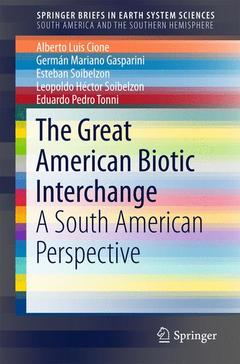The Great American Biotic Interchange, 2015 A South American Perspective SpringerBriefs in Earth System Sciences Series
Langue : Anglais
Auteurs : Cione Alberto Luis, Gasparini Germán Mariano, Soibelzon Esteban, Soibelzon Leopoldo Héctor, Tonni Eduardo Pedro

South American ecosystems suffered one of the greatest biogeographical events, after the establishment of the Panamian land bridge, called the ?Great American Biotic Interchange? (GABI). This refers to the exchange, in several phases, of land mammals between the Americas; this event started during the late Miocene with the appearance of the Holartic Procyonidae (Huayquerian Age) in South America and continues today. The major phases of mammalian dispersal occurred from the Latest Pliocene (Marplatan Age) to the Late Pleistocene (Lujanian Age). The most important and richest localities of Late Miocene-Holocene fossil vertebrates of South America are those of the Pampean region of Argentina. There are also several Late Miocene and Pliocene localities in western Argentina and Bolivia. Other important fossils have been collected in localities of Pleistocene age outside Argentina: Tarija (Bolivia), karstic caves of Lagoa Santa and the recently explored caves of Tocantins (Brasil), Talara (Perú), La Carolina (Ecuador), Muaco (Venezuela), and Cueva del Milodon (Chile), among others. The book discusses basic information for interpreting the GABI such as taxonomic composition (incorporating the latest revisions) at classical and new localities for each stage addressing climate, environments, and time boundaries for each stage. It includes the chronology and dynamics of the GABI, the integration of South American mammalian faunas through time, the Quaternary mammalian extinctions and the composition of recent mammalian fauna of the continent.
The history of the Great American Biotic Interchange concept.- Continents involved in the GABI.- Landbridges between previously isolated continents.- Chronology, Stratigraphy and Paleoclimatology of South America since Late Miocene to the Recent.- Objectives and hypothesis.- Methods.- Stratigraphic conceptual framework.- Taxonomic diversity: native, immigrant, and in situ differentiated taxa.- Paleoecology: body mass and diet estimations.- Analysis of Immigrant Mammal Fauna through the Diffferent Ages.- Huayquerian Age.- Montehermosan Age.- Chapadmalalan Age.- Marplatan Age.- Ensenadan Age.- Bonaerian Ag.- Lujanian Age.- Platan Age.- Discussion.- The GABI chronology and dynamics.- Integration of South American mammalian faunas: native and immigrant taxa coexisting.- Quaternary mammalian extinctions in South American Composition of recent mammalian fauna of South America.
All the authors are associated with the Department of Vertebrate Paleontology of the Museo de La Plata in Argentina. Alberto Luis Cione, Germán Mariano Gasparini and Esteban Soibelzon are members of Argentina's National Scientific and Technical Research Council (CONICET).
Presents a unique critique on The Great American Biotic Interchange The book presents an interesting analysis of immigrant mammal fauna through the ages The most important and richest localities of Late Miocene-Holocene fossil vertebrates of South America are those of the Pampean region of Argentina Includes supplementary material: sn.pub/extras
Date de parution : 05-2015
Ouvrage de 97 p.
15.5x23.5 cm
Thèmes de The Great American Biotic Interchange :
© 2024 LAVOISIER S.A.S.



